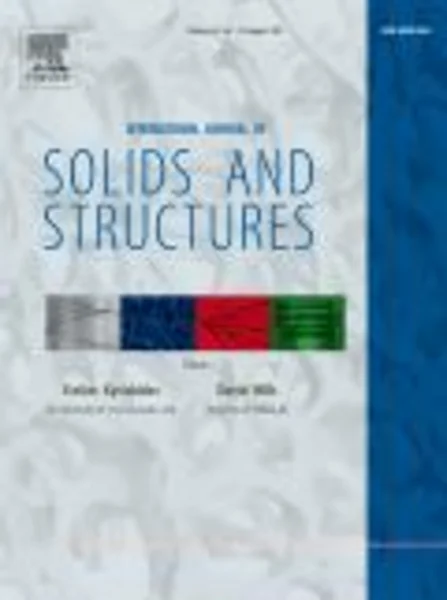-
strain gradient solution for a finite-domain eshelby-type plane strain inclusion problem and eshelby’s tensor for a cylindrical inclusion in a finite elastic matrix
جزئیات بیشتر مقاله- تاریخ ارائه: 1392/01/01
- تاریخ انتشار در تی پی بین: 1392/01/01
- تعداد بازدید: 912
- تعداد پرسش و پاسخ ها: 0
- شماره تماس دبیرخانه رویداد: -
a solution for the finite-domain eshelby-type inclusion problem of a finite elastic body containing a plane strain inclusion prescribed with a uniform eigenstrain and a uniform eigenstrain gradient is derived in a general form using a simplified strain gradient elasticity theory (ssget). the formulation is facilitated by an extended betti’s reciprocal theorem and an extended somigliana’s identity based on the ssget and suitable for plane strain problems. the disturbed displacement field is obtained in terms of the ssget-based green’s function for an infinite plane strain elastic body, which differs from that in earlier studies using the three-dimensional green’s function. the solution reduces to that of the infinite-domain inclusion problem when the boundary effect is suppressed. the problem of a cylindrical inclusion embedded concentrically in a finite plane strain cylindrical elastic matrix of an enhanced continuum is analytically solved for the first time by applying the general solution, with the eshelby tensor and its average over the circular cross section of the inclusion obtained in closed forms. this eshelby tensor, being dependent on the position, inclusion size, matrix size, and a material length scale parameter, captures the inclusion size and boundary effects, unlike existing ones. it reduces to the classical elasticity-based eshelby tensor for the cylindrical inclusion in an infinite matrix if both the strain gradient and boundary effects are not considered. numerical results quantitatively show that the inclusion size effect can be quite large when the inclusion is very small and that the boundary effect can dominate when the inclusion volume fraction is very high. however, the inclusion size effect is diminishing with the increase of the inclusion size, and the boundary effect is vanishing as the inclusion volume fraction becomes sufficiently low.
مقالات جدیدترین رویدادها
-
استفاده از تحلیل اهمیت-عملکرد در ارائه الگوی مدیریت خلاقیت سازمانی و ارائه راهکار جهت بهبود
-
بررسی تاثیر ارزش وجوه نقد مازاد بر ساختار سرمایه شرکت های پذیرفته شده در بورس اوراق بهادار تهران
-
بررسی تأثیر سطح افشای ریسک بر قرارداد بدهی شرکت های پذیرفته شده در بورس اوراق بهادار تهران
-
بررسی تأثیر رتبه بندی اعتباری مبتنی بر مدل امتیاز بازار نوظهور بر نقد شوندگی سهام با تأکید بر خصوصی سازی شرکت ها
-
تأثیر آمیخته بازاریابی پوشاک ایرانی بر تصویر ذهنی مشتری پوشاک ایرانی (هاکوپیان)
-
تعیین تنش های برشی و قائم در سطح مشترک بینِ تیر rc و ورق های تقویت کننده ی هیبریدی gfrp ,cfrp
-
بررسی خواص بتن خود تراکم تازه حاوی مس باره به عنوان مصالح سنگی ریز دانه
-
تأثیر دین و باورهای دینی بر سلامت روان و کاهش آسیب های اجتماعی دانشجویان دانشگاه اراک
-
عوامل رنگ زا در گوهر سنگ های آمتیست جنوب طرود
-
بررسی تاثیر مسئولیت اجتماعی بر ثبات رفتاری مشتریان (مطالعه موردی: مشتریان بیمه تامین اجتماعی روستاییان )
مقالات جدیدترین ژورنال ها
-
مدیریت و بررسی افسردگی دانش آموزان دختر مقطع متوسطه دوم در دروان کرونا در شهرستان دزفول
-
مدیریت و بررسی خرد سیاسی در اندیشه ی فردوسی در ادب ایران
-
واکاوی و مدیریت توصیفی قلمدان(جاکلیدی)ضریح در موزه آستان قدس رضوی
-
بررسی تاثیر خلاقیت، دانش و انگیزه کارکنان بر پیشنهادات نوآورانه کارکنان ( مورد مطالعه: هتل های 3 و 4 ستاره استان کرمان)
-
بررسی تاثیر کیفیت سیستم های اطلاعاتی بر تصمیم گیری موفق در شرکتهای تولیدی استان اصفهان (مورد مطالعه: مدیران شرکتهای تولیدی استان اصفهان)
-
ارزیابی کارایی شعبات ادارات کل امور مالیاتی تهران با استفاده از تحلیل پوششی داده ها
-
اندازه گیری و رتبه بندی کارایی شرکتهای داروسازی پذیرفته شده در بورس اوراق بهادار تهران با استفاده از روش تاپسیس و تحلیل پوششی داده ها
-
بررسی علل و عوامل مرتبط در گرایش جوانان به مصرف مواد مخدر (مطالعه موردی منطقه جلگه چاه هاشم)
-
quantum chemistry calculations based on the density functional theory on diazinon pesticides
-
a novel type of alkaline activator for geopolymer concrete based on metakaolin




سوال خود را در مورد این مقاله مطرح نمایید :